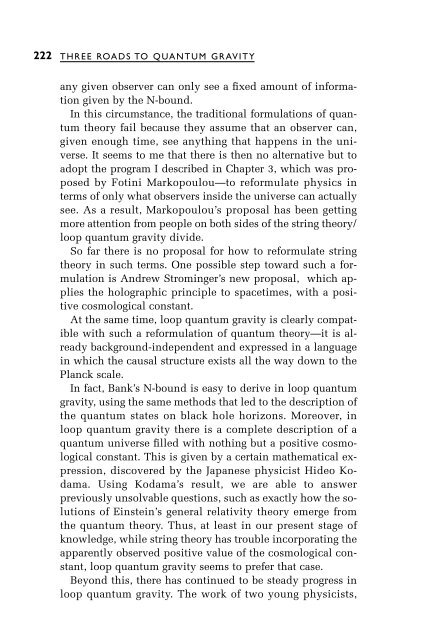Three Roads To Quantum Gravity
Three Roads To Quantum Gravity
Three Roads To Quantum Gravity
Create successful ePaper yourself
Turn your PDF publications into a flip-book with our unique Google optimized e-Paper software.
222<br />
THREE ROADS TO QUANTUM GRAVITY<br />
any given observer can only see a fixed amount of information<br />
given by the N-bound.<br />
In this circumstance, the traditional formulations of quantum<br />
theory fail because they assume that an observer can,<br />
given enough time, see anything that happens in the universe.<br />
It seems to me that there is then no alternative but to<br />
adopt the program I described in Chapter 3, which was proposed<br />
by Fotini Markopoulou—to reformulate physics in<br />
terms of only what observers inside the universe can actually<br />
see. As a result, Markopoulou’s proposal has been getting<br />
more attention from people on both sides of the string theory/<br />
loop quantum gravity divide.<br />
So far there is no proposal for how to reformulate string<br />
theory in such terms. One possible step toward such a formulation<br />
is Andrew Strominger’s new proposal, which applies<br />
the holographic principle to spacetimes, with a positive<br />
cosmological constant.<br />
At the same time, loop quantum gravity is clearly compatible<br />
with such a reformulation of quantum theory—it is already<br />
background-independent and expressed in a language<br />
in which the causal structure exists all the way down to the<br />
Planck scale.<br />
In fact, Bank’s N-bound is easy to derive in loop quantum<br />
gravity, using the same methods that led to the description of<br />
the quantum states on black hole horizons. Moreover, in<br />
loop quantum gravity there is a complete description of a<br />
quantum universe filled with nothing but a positive cosmological<br />
constant. This is given by a certain mathematical expression,<br />
discovered by the Japanese physicist Hideo Kodama.<br />
Using Kodama’s result, we are able to answer<br />
previously unsolvable questions, such as exactly how the solutions<br />
of Einstein’s general relativity theory emerge from<br />
the quantum theory. Thus, at least in our present stage of<br />
knowledge, while string theory has trouble incorporating the<br />
apparently observed positive value of the cosmological constant,<br />
loop quantum gravity seems to prefer that case.<br />
Beyond this, there has continued to be steady progress in<br />
loop quantum gravity. The work of two young physicists,



![arXiv:1001.0993v1 [hep-ph] 6 Jan 2010](https://img.yumpu.com/51282177/1/190x245/arxiv10010993v1-hep-ph-6-jan-2010.jpg?quality=85)


![arXiv:1008.3907v2 [astro-ph.CO] 1 Nov 2011](https://img.yumpu.com/48909562/1/190x245/arxiv10083907v2-astro-phco-1-nov-2011.jpg?quality=85)








![arXiv:1002.4928v1 [gr-qc] 26 Feb 2010](https://img.yumpu.com/41209516/1/190x245/arxiv10024928v1-gr-qc-26-feb-2010.jpg?quality=85)
![arXiv:1206.2653v1 [astro-ph.CO] 12 Jun 2012](https://img.yumpu.com/39510078/1/190x245/arxiv12062653v1-astro-phco-12-jun-2012.jpg?quality=85)
